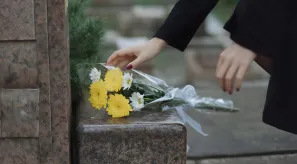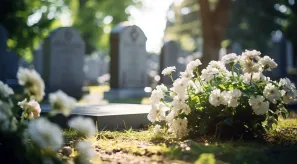Cemeteries not only provide us with somewhere to pay our respects to loved ones, but they also hide secrets which can tell us so much more about these places of remembrance. We can find sculptures, unusual funerary monuments, tombs of famous people and other peculiarities that all share an important historical and cultural value. Today at Stelae, we will delve into this as we take a look at the largest cemeteries in Spain.
List of the largest cemeteries in Spain
Which is the largest cemetery in Spain? Discover the most surprising facts about the most important cemeteries in our country...
Nuestra Señora de la Almudena Cemetery, Madrid
Did you know that the largest cemetery in Western Europe is in Spain? With 120 hectares, the Almudena Cemetery is not only the largest in Spain, but also in most of the continent.
It was inaugurated in 1884 and today it houses more deceased people than the city of Madrid has inhabitants. It is estimated that around 5 million people have been buried in this cemetery.
Originally it was not as large, but over the years the cemetery has undergone a major transformation in response to the growing number of people who have been buried there. It has seen several extensions and has also been the burial place of famous people such as King Alfonso XIII and the painter Francisco Goya.
Montjuic Cemetery , Barcelona
Another of the largest cemeteries in Spain is Montjuic Cemetery in Barcelona which is also one of the most emblematic and popular tourist sites in the city.
It is located on the mountain and offers impressive views of Barcelona. It also houses a large number of mausoleums, sculptures and pantheons of great artistic and cultural value. It is one of the largest and oldest cemeteries in the country. In fact, Catalonia is the region which is home to the most unique cemeteries in Spain thanks to its cultural heritage.
Carabanchel Cemetery, Madrid
The Sacramental de San Isidro, or the Old Cemetery as it is also known, was built in the Carabanchel neighbourhood in 1811. It is the second oldest cemetery in Madrid and the first to be located outside the city centre.
It was declared a Cultural Interest Asset because it houses Neo-Gothic, Art Deco and Modernist pantheons, which make it a mixture of art, history and nature.
It is also the resting place of many illustrious figures. This is because it became the cemetery of the nobility in Madrid during the 19th century. Inside, the graves of José Ortega y Gasset, Diego de León, Emilio Castelar, Francisco Silvela, Concha Márquez Piquer, Miguel Boyer and María del Pilar de Borbón can be found, among others.
General Cemetery of Valencia, Valencia
The General Cemetery of Valencia is also known as the ‘Cemetery of Forgotten Books’. Construction began in 1805 and it is one of the great works of Spanish neoclassical architecture.
Inside, there are a number of pantheons and sculptures in the modernist style with an important architectural significance. It also houses the tombs of prominent figures such as Joaquín Sorolla, Vicente Blasco Ibáñez and Nino Bravo.
Cultural and touristic importance of Spain's largest cemeteries
Spain's largest cemeteries are important not only because of their size, but also because they are testimony to the country's own history. On the gravestones and in the mausoleums we can spot celebrities from all walks of life including politics, art and literature.
Most of the gravestones and mausoleums are very old so within their walls a journey can be taken through different artistic and architectural styles over the years.
They are also a reflection of the beliefs and traditions of each era. Packed with religious symbolism, they help us to understand how our ancestors viewed death.
As a result, they are a fundamental asset to our heritage and they should be preserved. Restoration work is often carried out to recondition and maintain sculptures, monuments and other works of art. All in all, a journey through the largest cemeteries in Spain is also a walk through our history, art and traditions. This is why many cemeteries today are popular tourist destinations.
Advice when visiting Spain's largest cemeteries
Are you thinking of visiting one of Spain's largest cemeteries? If so, here is some advice to help you:
- Be respectful during your visit.
- Contribute to artistic and heritage conservation.
- Do some research and plan your trip efficiently so you can visit the most interesting places.
- Follow the rules indicated in the cemetery.
A visit to one of Spain's largest cemeteries allows you to discover its artistic, historical, cultural and natural heritage. It should also be remembered that cemeteries are a spiritual space for those who are visiting their loved ones, which is why respect must be shown at all times during your visit.
Remember that cemeteries are not the only resting place for our loved ones. Cremation is an option that is being considered by more and more people. You may be interested in the price of a cremation which can vary depending on the type of funeral services you wish to include.



